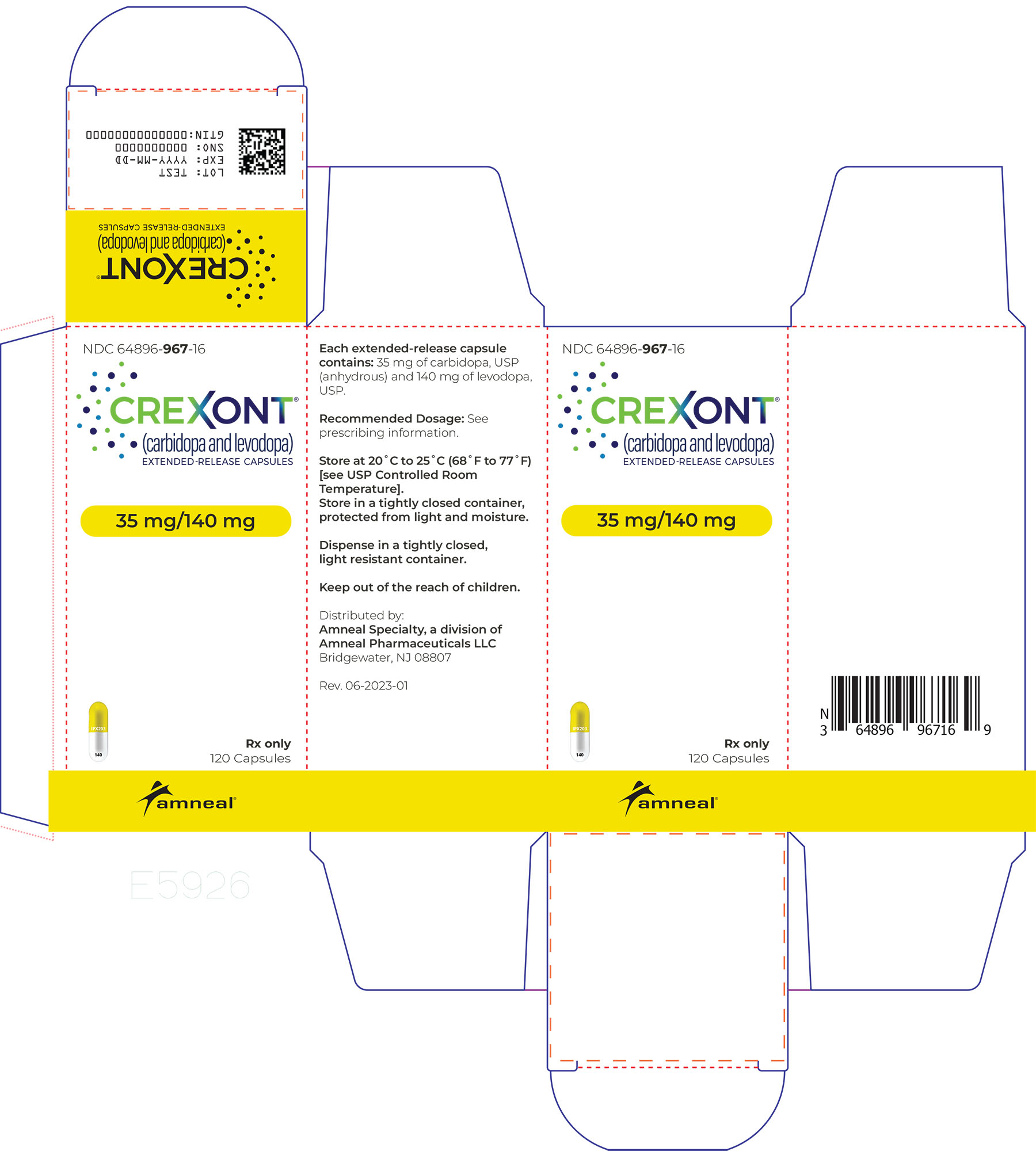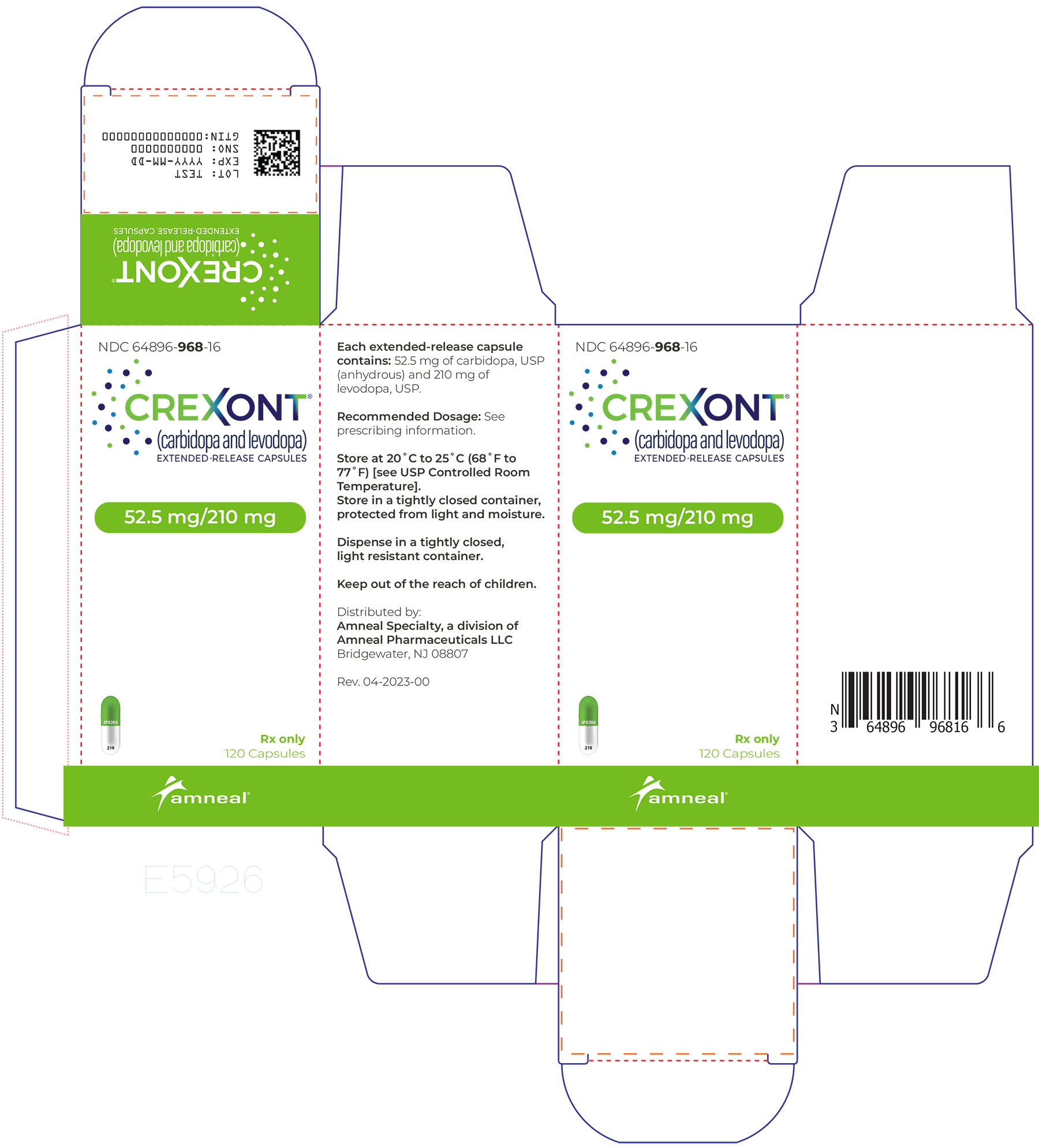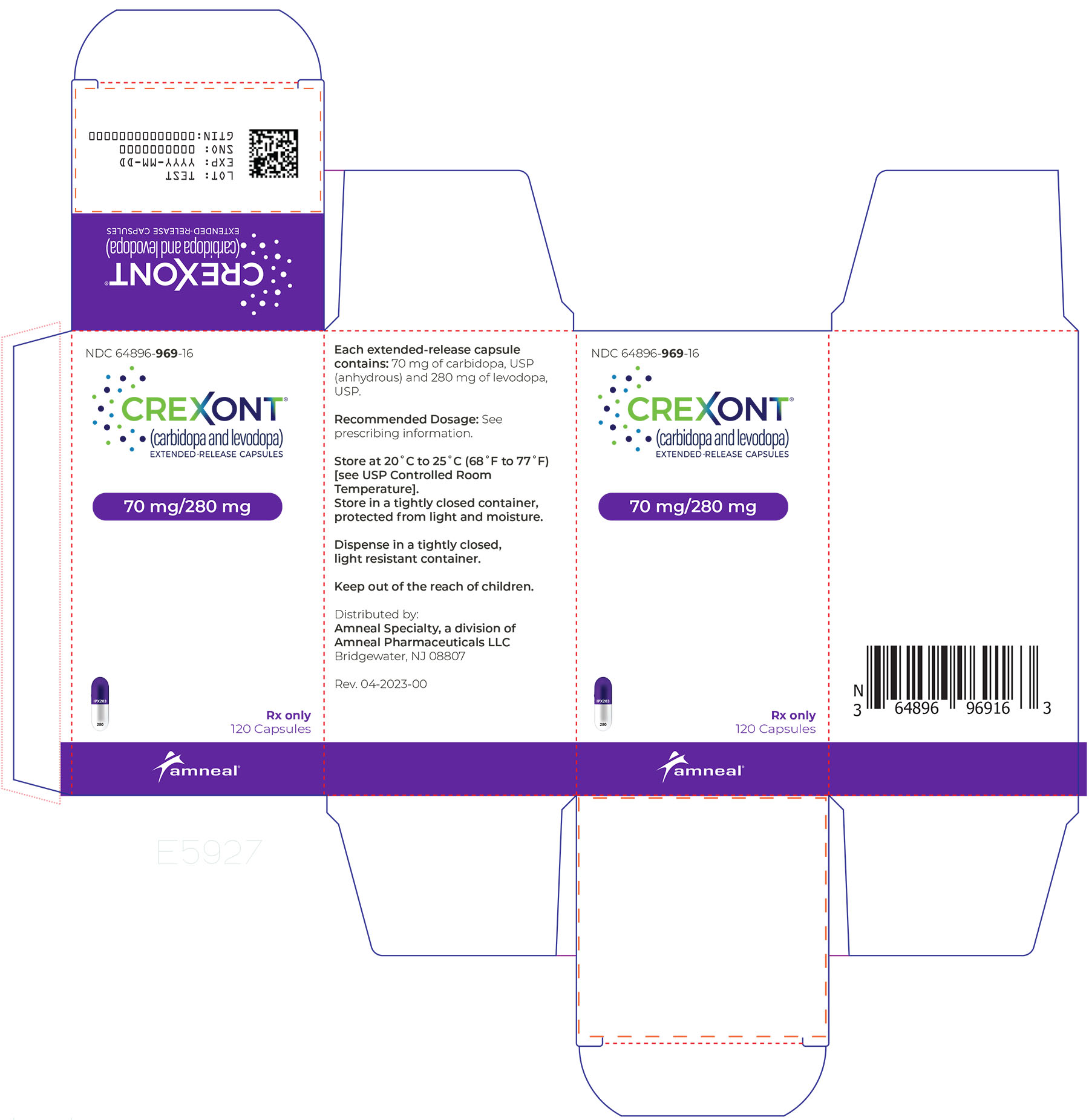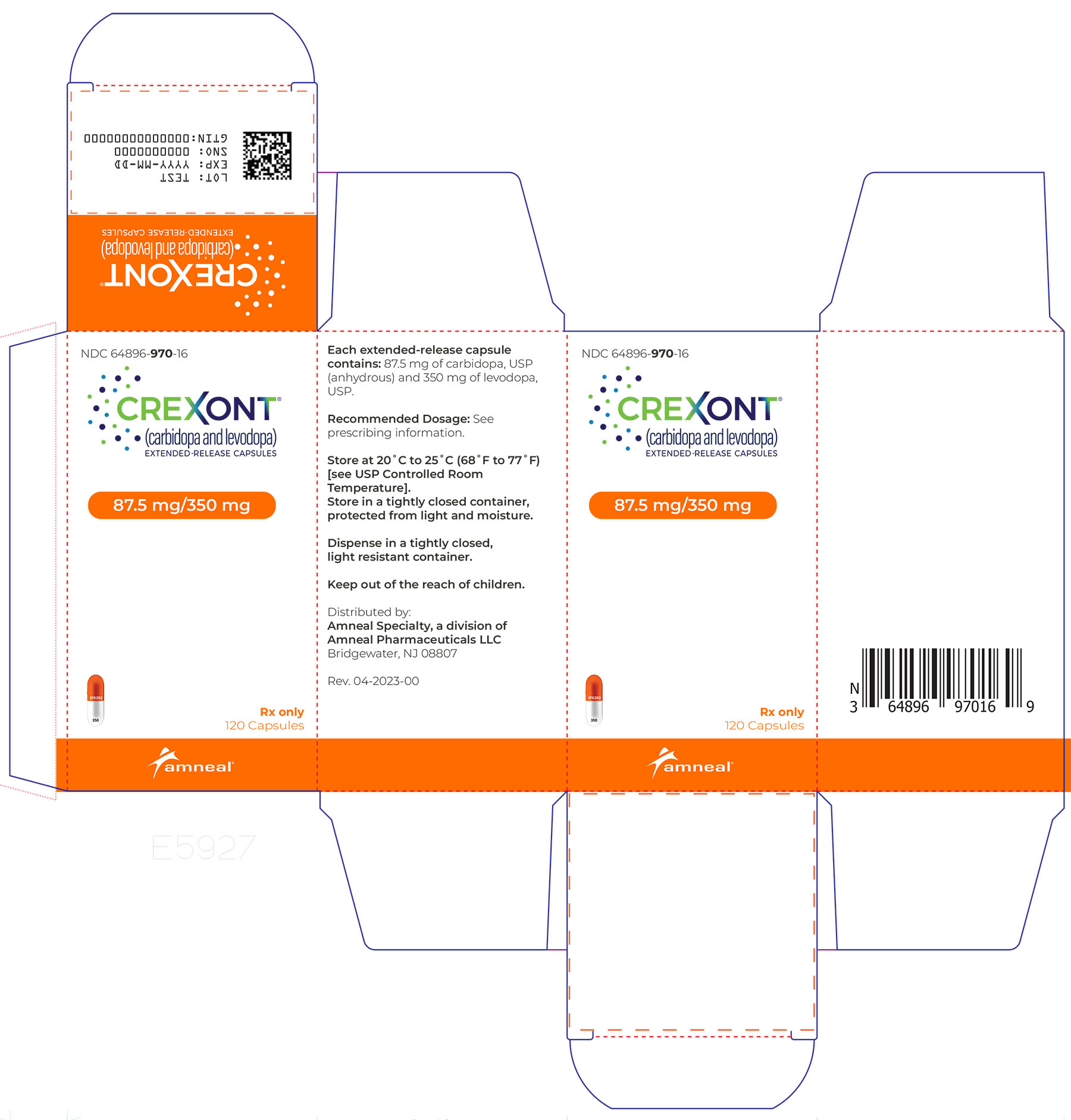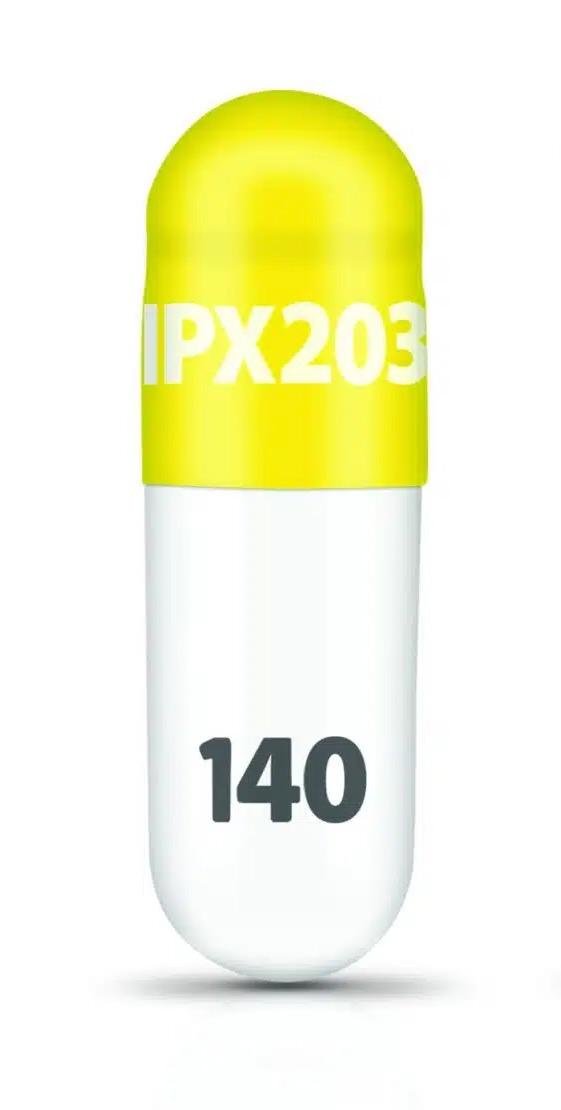Crexont Prescribing Information
Package insert / product label
Generic name: carbidopa and levodopa
Dosage form: capsule, extended release
Drug class: Dopaminergic antiparkinsonism agents
Medically reviewed by Drugs.com. Last updated on Aug 14, 2024.
On This Page
- Indications and Usage
- Dosage and Administration
- Dosage Forms and Strengths
- Contraindications
- Warnings and Precautions
- Adverse Reactions/Side Effects
- Drug Interactions
- Use In Specific Populations
- Overdosage
- Description
- Clinical Pharmacology
- Nonclinical Toxicology
- Clinical Studies
- How Supplied/Storage and Handling
- Patient Counseling Information
Highlights of Prescribing Information
CREXONT® (carbidopa and levodopa) extended-release capsules, for oral use
Initial U.S. Approval: 1975
Indications and Usage for Crexont
CREXONT is a combination of carbidopa (an aromatic amino acid decarboxylation inhibitor) and levodopa (an aromatic amino acid) indicated for the treatment of Parkinson’s disease, post-encephalitic parkinsonism, and parkinsonism that may follow carbon monoxide intoxication or manganese intoxication in adults. (1)
Crexont Dosage and Administration
- Levodopa-naïve patients: Starting dose is 35 mg carbidopa / 140 mg levodopa taken orally twice daily for the first 3 days; on the fourth day of treatment, dosage may be increased gradually as needed. (2.1)
- Patients converting from immediate-release carbidopa/levodopa: See Table 1 for instructions; dosages are not substitutable on a 1:1 basis. (2.2)
- The maximum recommended daily dosage of CREXONT is 525 mg carbidopa / 2100 mg levodopa. (2.1, 2.2)
- CREXONT may be taken with or without food; do not chew, divide, or crush. (2.4, 12.3)
- CREXONT should not be taken with alcohol. (2.4, 12.3)
Dosage Forms and Strengths
Extended-Release Capsules: Carbidopa and Levodopa 35 mg / 140 mg, 52.5 mg / 210 mg, 70 mg / 280 mg, 87. 5 mg / 350 mg (3)
Contraindications
- Nonselective MAO inhibitors (4)
Warnings and Precautions
- May cause falling asleep during activities of daily living. (5.1)
- Avoid sudden discontinuation or rapid dose reduction to reduce the risk of withdrawal-emergent hyperpyrexia and confusion. (5.2)
- Cardiovascular Events: Monitor patients with a history of cardiovascular disease. (5.3)
- Hallucinations/Psychosis may occur. (5.4)
- Impulse Control Disorders: Consider dose reduction or stopping CREXONT if occurs. (5.5)
- May cause or exacerbate dyskinesia: Consider dose reduction. (5.6)
Adverse Reactions/Side Effects
The most common adverse reactions (incidence ≥ 3% and greater than immediate-release CD-LD) are nausea and anxiety. (6.1)
To report SUSPECTED ADVERSE REACTIONS, contact Amneal Pharmaceuticals at 1-877-835-5472 or FDA at 1-800-FDA-1088 or www.fda.gov/medwatch.
Drug Interactions
Use In Specific Populations
Pregnancy: Based on animal data, may cause fetal harm. (8.1)
See 17 for PATIENT COUNSELING INFORMATION.
Revised: 8/2024
Full Prescribing Information
1. Indications and Usage for Crexont
CREXONT is indicated for the treatment of Parkinson's disease, post-encephalitic parkinsonism, and parkinsonism that may follow carbon monoxide intoxication or manganese intoxication in adults.
2. Crexont Dosage and Administration
2.1 Dosage in Patients Naïve to Levodopa Therapy
The recommended starting dosage of CREXONT in levodopa-naïve patients is 35 mg carbidopa / 140 mg levodopa taken orally twice daily for the first three days. Thereafter, dosage may be increased gradually as needed to a maximum daily dosage of 525 mg carbidopa / 2100 mg levodopa divided up to four times daily.
2.2 Dosage in Patients Converting from Immediate-Release Carbidopa-Levodopa to CREXONT
The dosages of immediate-release carbidopa-levodopa products are not substitutable on a 1:1 basis with the dosages of CREXONT.
To convert patients from immediate-release carbidopa-levodopa to CREXONT, follow these steps:
Step 1: Determine the patient’s total daily dosage of immediate-release levodopa.
Step 2: Determine the patient’s most frequent single dose of immediate-release levodopa. If more than one dose corresponds to the most frequent, use the highest of the doses.
Step 3: Find the values from Step 1 and Step 2 in Table 1 (below) to determine the recommended starting CREXONT dosage of levodopa and dosing frequency.
Step 4: After one to three days, adjust the dose or frequency as needed based on the patient’s clinical response and tolerability. Dosage may be increased gradually as needed to a maximum daily dosage of 525 mg carbidopa / 2100 mg levodopa divided up to four times daily.
Table 1: Conversion from Immediate-Release Carbidopa-Levodopa to CREXONT
|
Total Daily Immediate-Release Levodopa Dosage |
Most Frequent Immediate-Release Levodopa Single Dose |
Recommended Starting CREXONT Dosage of Levodopa |
|
Less than 500 mg daily |
100 mg |
280 mg twice daily |
|
150 mg |
420 mg twice daily |
|
|
200 mg |
560 mg twice daily |
|
|
Equal to or greater than 500 mg daily |
100 mg |
280 mg three times daily |
|
150 mg |
420 mg three times daily |
|
|
200 mg |
560 mg three times daily |
|
|
Greater than 200 mg |
700 mg three times daily |
For patients currently treated with carbidopa and levodopa plus a catechol-O-methyl transferase (COMT) inhibitor (e.g., entacapone or opicapone), the initial total daily dose of levodopa in CREXONT may need to be increased if the COMT inhibitor is discontinued.
Use of CREXONT in combination with other levodopa products has not been studied.
2.3 Dosage for Patients Converting from Extended-Release Carbidopa-Levodopa (Rytary) to CREXONT
For patients converting from RYTARY (extended-release carbidopa-levodopa), initiate CREXONT on an approximately 1:1 mg basis using the levodopa component for conversion.
2.4 Administration Information
Swallow CREXONT whole with or without food. CREXONT should not be taken with alcohol. A high-fat, high-calorie meal may delay the absorption of levodopa to reach the peak plasma concentration by about 2 hours [see Clinical Pharmacology (12.3)].
Do not chew, divide, or crush CREXONT capsules.
2.5 Discontinuation of CREXONT
Avoid sudden discontinuation or rapid dose reduction of CREXONT. The daily dose of CREXONT should be tapered at the time of treatment discontinuation [see Warnings and Precautions (5.2)].
3. Dosage Forms and Strengths
CREXONT extended-release capsules contain white to off-white granules and pellets and are available in the following strengths:
- 35 mg carbidopa and 140 mg levodopa: Capsules with white opaque body and yellow opaque cap. Body imprinted with “140” in black ink and cap imprinted with “IPX203” in white ink.
- 52.5 mg carbidopa and 210 mg levodopa: Capsules with white opaque body and green opaque cap. Body imprinted with “210” in black ink and cap imprinted with “IPX203” in white ink.
- 70 mg carbidopa and 280 mg levodopa: Capsules with white opaque body and purple opaque cap. Body imprinted with “280” in black ink and cap imprinted with “IPX203” in white ink.
- 87.5 mg carbidopa and 350 mg levodopa: Capsules with white opaque body and medium orange opaque cap. Body imprinted with “350” in black ink and cap imprinted with “IPX203” in white ink.
4. Contraindications
CREXONT is contraindicated in patients currently taking a nonselective monoamine oxidase (MAO) inhibitor or have recently (within 2 weeks) taken a nonselective MAO inhibitor. Hypertension can occur if these drugs are used concurrently [see Drug Interactions (7.1)].
5. Warnings and Precautions
5.1 Falling Asleep During Activities of Daily Living and Somnolence
Patients treated with levodopa, a component of CREXONT, have reported falling asleep while engaged in activities of daily living, including the operation of motor vehicles, which sometimes resulted in accidents. Although many of these patients reported somnolence while on levodopa, some perceived that they had no warning signs, such as excessive drowsiness, and believed that they were alert immediately prior to the event (sleep attack). Some of these events have been reported more than 1 year after initiation of treatment.
Falling asleep while engaged in activities of daily living usually occurs in patients experiencing preexisting somnolence, although patients may not give such a history. For this reason, prescribers should reassess for drowsiness or sleepiness in CREXONT-treated patients, especially since some of the events occur well after the start of treatment. Prescribers should also be aware that patients may not acknowledge drowsiness or sleepiness until directly questioned about drowsiness or sleepiness during specific activities.
Before initiating treatment with CREXONT, advise patients of the potential to develop drowsiness and specifically ask about factors that may increase the risk for somnolence with CREXONT, such as concomitant sedating medications or the presence of a sleep disorder. Consider discontinuing CREXONT in patients who report significant daytime sleepiness or episodes of falling asleep during activities that require active participation (e.g., conversations, eating, etc.).
If a decision is made to continue CREXONT, patients should be advised not to drive and to avoid other potentially dangerous activities that might result in harm if the patients become somnolent. There is insufficient information to establish that dose reduction will eliminate episodes of falling asleep while engaged in activities of daily living.
5.2 Withdrawal-Emergent Hyperpyrexia and Confusion
A symptom complex that resembles neuroleptic malignant syndrome (characterized by elevated temperature, muscular rigidity, altered consciousness, and autonomic instability), with no other obvious etiology, has been reported in association with rapid dose reduction, withdrawal of, or changes in dopaminergic therapy. Avoid sudden discontinuation or rapid dose reduction in patients taking CREXONT. If the decision is made to discontinue CREXONT, the dose should be tapered to reduce the risk of hyperpyrexia and confusion [see Dosage and Administration (2.5)].
5.3 Cardiovascular Ischemic Events
Cardiovascular ischemic events have occurred in patients taking CREXONT. In Study 1 [see Clinical Studies (14)], 4/589 (0.7%) of CREXONT-treated patients experienced cardiovascular ischemic adverse reactions compared to 2/630 (0.3%) of oral immediate-release carbidopa-levodopa-treated patients. These patients all had a previous history of ischemic heart disease or risk factors for ischemic heart disease.
In patients with a history of myocardial infarction who have residual atrial, nodal, or ventricular arrhythmias, cardiac function should be monitored in an intensive cardiac care facility during the period of initial dosage adjustment.
5.4 Hallucinations/Psychosis
There is an increased risk for hallucinations in patients taking CREXONT. In Study 1, 17/589 (3%) of CREXONT-treated patients reported hallucinations compared to 2/630 (0.3%) of oral immediate-release carbidopa-levodopa-treated patients.
Hallucinations present shortly after the initiation of therapy and may be responsive to dose reduction in levodopa. Hallucinations may be accompanied by confusion, insomnia, and excessive dreaming. Abnormal thinking and behavior may present with one or more symptoms, including paranoid ideation, delusions, hallucinations, confusion, psychotic-like behavior, disorientation, aggressive behavior, agitation, and delirium.
Because of the risk of exacerbating psychosis, patients with a major psychotic disorder should not be treated with CREXONT. In addition, medications that antagonize the effects of dopamine used to treat psychosis may exacerbate the symptoms of Parkinson’s disease and may decrease the effectiveness of CREXONT [see Drug Interactions (7.2)].
5.5 Impulse Control/Compulsive Behaviors
Case reports suggest that patients can experience intense urges to gamble, increased sexual urges, intense urges to spend money, binge eating, and/or other intense urges, and the inability to control these urges while taking one or more of the medications, including CREXONT, that increase central dopaminergic tone and that are generally used for the treatment of Parkinson’s disease. In some cases, although not all, these urges were reported to have stopped when the dose was reduced or the medication was discontinued.
Because patients may not recognize these behaviors as abnormal, it is important for prescribers to specifically ask patients or their caregivers about the development of new or increased gambling urges, sexual urges, uncontrolled spending, or other urges while being treated with CREXONT. Consider a dose reduction or stopping the medication if a patient develops such urges while taking CREXONT.
5.6 Dyskinesia
CREXONT can cause dyskinesias that may require a dosage reduction of CREXONT or other medications used for the treatment of Parkinson’s disease.
6. Adverse Reactions/Side Effects
The following serious adverse reactions are discussed below and elsewhere in the labeling:
- Falling Asleep During Activities of Daily Living and Somnolence [see Warnings and Precautions (5.1)]
- Withdrawal-Emergent Hyperpyrexia and Confusion [see Warnings and Precautions (5.2)]
- Cardiovascular Ischemic Events [see Warnings and Precautions (5.3)]
- Hallucinations/Psychosis [see Warnings and Precautions (5.4)]
- Impulse Control/Compulsive Behaviors [see Warnings and Precautions (5.5)]
- Dyskinesia [see Warnings and Precautions (5.6)]
- Peptic Ulcer Disease [see Warnings and Precautions (5.7)]
- Glaucoma [see Warnings and Precautions (5.8)]
6.1 Clinical Trials Experience
Because clinical trials are conducted under widely varying conditions, adverse reaction rates observed in the clinical trials of a drug cannot be directly compared to rates in the clinical trials of another drug and may not reflect the rates observed in clinical practice.
The safety population consisted of 589 patients with Parkinson’s disease who received CREXONT for up to 76 weeks and had an average duration of exposure of 35 weeks. Study 1 in patients with Parkinson’s Disease consisted of a dose adjustment period of immediate-release carbidopa-levodopa treatment prior to a 4-week dose conversion period to CREXONT, which was then followed by a 13-week, double-blind, randomized period comparing CREXONT to immediate-release carbidopa-levodopa [see Clinical Studies (14)].
In Study 1, the most common adverse reactions (in at least 3% of patients treated with CREXONT and more frequently than with immediate-release carbidopa-levodopa) that occurred during the double-blind maintenance period were nausea and anxiety.
Table 2 lists adverse reactions occurring in at least 2% of CREXONT-treated patients while converting from immediate-release carbidopa-levodopa and at a higher rate than immediate-release carbidopa-levodopa in the double-blind maintenance period.
Table 2. Adverse Reactions that Occurred in at Least 2% of Patients with Parkinson’s Disease who Received CREXONT and at a Higher Rate than Patients who Received Immediate-Release Carbidopa-Levodopa (Study 1)
|
Adverse Reaction |
Dose Conversion Period |
Double-Blind Period |
|
|
CREXONT |
CREXONT |
Immediate-Release Carbidopa-Levodopa |
|
|
(N=589) % |
(N=256) % |
(N= 250) % |
|
|
Nausea |
5 |
4 |
1 |
|
Anxiety |
2 |
3 |
0 |
|
Dizziness |
3 |
2 |
1 |
|
Dyskinesia |
7 |
2 |
0.4 |
|
Constipation |
2 |
2 |
0.4 |
|
Headache |
2 |
1 |
0 |
|
Vomiting |
2 |
1 |
0 |
|
Insomnia |
2 |
1 |
0.4 |
Adverse Reactions Leading to Discontinuation
In Study 1, 6% of patients discontinued treatment because of adverse reactions during conversion to CREXONT. During the double-blind treatment period of Study 1, 5% of patients taking CREXONT and 1% of patients taking immediate-release carbidopa-levodopa discontinued treatment because of adverse events.
The common adverse reactions leading to drug discontinuation during dose conversion were dyskinesia, dizziness, and nausea.
7. Drug Interactions
7.1 Monoamine Oxidase (MAO) Inhibitors
Nonselective MAO Inhibitors
The use of nonselective MAO inhibitors (e.g., phenelzine and tranylcypromine) with CREXONT is contraindicated [see Contraindications (4)]. Discontinue use of any nonselective MAO inhibitors at least two weeks prior to initiating CREXONT.
Selective MAO Inhibitors
The use of selective MAO-B inhibitors (e.g., rasagiline and selegiline) with CREXONT may be associated with orthostatic hypotension. Monitor patients who are taking these drugs concurrently.
7.2 Dopamine D2 Receptor Antagonists and Isoniazid
Dopamine D2 receptor antagonists (e.g., phenothiazines, butyrophenones, risperidone, metoclopramide) and isoniazid may reduce the effectiveness of levodopa. Monitor patients for worsening Parkinson’s symptoms.
7.3 Iron Salts
Iron salts or multivitamins containing iron salts can form chelates with levodopa and carbidopa and can cause a reduction in the bioavailability of CREXONT. If iron salts or multivitamins containing iron salts are co-administered with CREXONT, monitor patients for worsening Parkinson’s symptoms.
8. Use In Specific Populations
8.1 Pregnancy
Risk Summary
There are no adequate data on the developmental risk associated with the use of CREXONT (carbidopa and levodopa) in pregnant women. In animal studies, carbidopa-levodopa has been shown to be developmentally toxic (including teratogenic effects) at clinically relevant doses (see Data).
The estimated background risk of major birth defects and miscarriage in the indicated population is unknown. In the U.S. general population, the estimated background risk of major birth defects and miscarriage in clinically recognized pregnancies is 2% to 4% and 15% to 20%, respectively.
Data
Animal Data
When administered to pregnant rabbits throughout organogenesis, carbidopa-levodopa caused both visceral and skeletal malformation in fetuses at all doses and ratios of carbidopa-levodopa tested. No teratogenic effects were observed when carbidopa-levodopa was administered to pregnant mice throughout organogenesis.
There was a decrease in the number of live pups delivered by rats receiving carbidopa-levodopa during organogenesis.
8.2 Lactation
Risk Summary
CREXONT is a combination of carbidopa and levodopa.
Carbidopa
There are no adequate data on the presence of carbidopa in human milk, the effects on the breastfed infant, or the effects on milk production. Carbidopa is excreted in rat milk.
Levodopa
Levodopa has been detected in human milk after administration of carbidopa-levodopa. Levodopa decreases secretion of prolactin in humans, which may inhibit lactation. There are no adequate data on the effects of levodopa on the breastfed infant.
The developmental and health benefits of breastfeeding should be considered along with the mother’s clinical need for CREXONT and any potential adverse effects on the breastfed infant from CREXONT or from the underlying maternal condition.
8.5 Geriatric Use
There were 282 (45%) patients 65 to less than 74 years of age and 112 (18%) patients 75 years of age and older treated with CREXONT in an active-controlled study for Parkinson’s disease (Study 1) [see Clinical Studies (14)]. There were no differences in safety outcomes between patients less than 65 years of age, 65 to less than 75 years of age, or 75 years and older.
10. Overdosage
Based on the limited available information, the acute symptoms of levodopa/carbidopa overdosage can be expected to arise from dopaminergic overstimulation. Doses of a few grams may result in CNS disturbances, with an increasing likelihood of cardiovascular disturbance (e.g., hypotension, tachycardia) and more severe psychiatric problems at higher doses. An isolated report of rhabdomyolysis and another of transient renal insufficiency suggest that levodopa overdosage may give rise to systemic complications, secondary to dopaminergic overstimulation.
In the event of CREXONT overdosage, monitor patients and provide supportive care. Patients should receive electrocardiographic monitoring for the development of arrhythmias; if needed, appropriate antiarrhythmic therapy should be given. The possibility that the patient may have taken other drugs, increasing the risk of drug interactions (especially catechol-structured drugs) should be taken into consideration.
11. Crexont Description
CREXONT is a combination of carbidopa, an inhibitor of aromatic amino acid decarboxylation, and levodopa, an aromatic amino acid, in extended-release capsules for oral use.
CREXONT contains immediate-release granules consisting of carbidopa and levodopa and extended-release pellets consisting of levodopa.
Carbidopa is a white to off-white powder, crystalline compound, slightly soluble in water, with a molecular weight of 244.24. It is designated chemically as (–)-L-α-hydrazino-α-methyl-β-(3,4-dihydroxy-benzene) propanoic acid monohydrate. Its molecular formula is C10H14N2O4•H2O and its structural formula is:
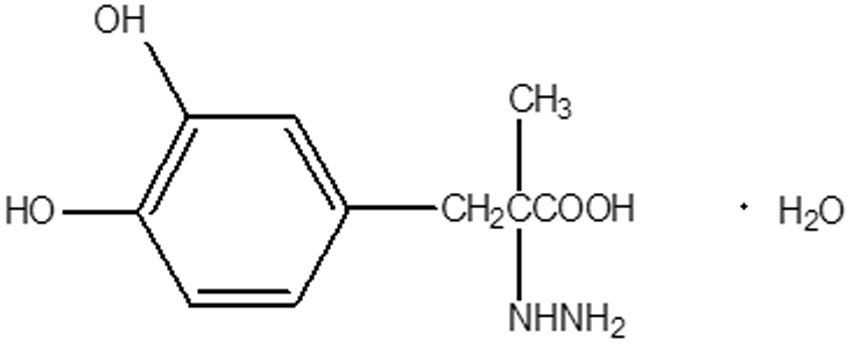
Capsule content is expressed in terms of anhydrous carbidopa, which has a molecular weight of 226.3.
Levodopa is a white, crystalline compound, slightly soluble in water, with a molecular weight of 197.2. It is designated chemically as (–)-L-α-amino-β-(3,4-dihydroxy-benzene) propanoic acid. Its molecular formula is C9H11NO4 and its structural formula is:
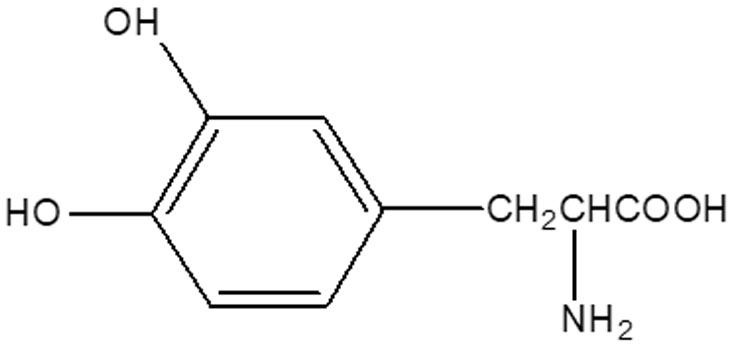
Each CREXONT extended-release capsule contains 35 mg carbidopa and 140 mg levodopa, 52.5 mg carbidopa and 210 mg levodopa, 70 mg carbidopa and 280 mg levodopa, or 87.5 mg carbidopa and 350 mg levodopa. The inactive ingredients are amino methacrylate copolymer, cellulose acetate, copovidone, croscarmellose sodium, magnesium stearate, mannitol, methacrylic acid and methyl methacrylate copolymer, microcrystalline cellulose, povidone, sodium lauryl sulfate, talc, and triethyl citrate.
- The 35mg/140 mg capsule shell contains D&C yellow #10, gelatin, Red Iron Oxide, and titanium dioxide.
- The 52.5 mg/210 mg capsule shell contains FD&C Blue #1, gelatin, titanium dioxide, and yellow iron oxide.
- The 70 mg/280 mg capsule shell contains FD&C Blue #1, FD&C Red #3, gelatin, and titanium dioxide.
- The 87.5 mg/350 mg capsule shell contains gelatin, Red Iron Oxide, titanium dioxide, and yellow iron oxide.
- The black imprinting ink contains ammonium hydroxide, ethanol, ferrosoferric oxide/black iron oxide, isopropyl alcohol, n-butyl alcohol, propylene glycol, and shellac glaze.
- The white imprinting ink contains ethanol, isopropyl alcohol, n-butyl alcohol, povidone, propylene glycol, shellac glaze, sodium hydroxide, and titanium dioxide.
12. Crexont - Clinical Pharmacology
12.1 Mechanism of Action
Carbidopa
When levodopa is administered orally, it is rapidly decarboxylated to dopamine in extracerebral tissues so that only a small portion of a given dose is transported unchanged to the central nervous system. Carbidopa inhibits the decarboxylation of peripheral levodopa, making more levodopa available for delivery to the brain.
Levodopa
Levodopa is the metabolic precursor of dopamine, does cross the blood-brain barrier, and presumably is converted to dopamine in the brain. This is thought to be the mechanism whereby levodopa treats symptoms of Parkinson's disease.
12.2 Pharmacodynamics
Because its decarboxylase inhibiting activity is limited to extracerebral tissues, administration of carbidopa with levodopa makes more levodopa available to the brain. The addition of carbidopa to levodopa reduces the peripheral effects (nausea, vomiting) due to decarboxylation of levodopa; however, carbidopa does not decrease the adverse reactions due to the central effects of levodopa.
Patients treated with levodopa therapy for Parkinson's disease may develop motor fluctuations characterized by end-of-dose failure, peak dose dyskinesia, ‘on-off’ phenomenon, and akinesia.
Cardiac Electrophysiology
At exposures corresponding to the maximum recommended dose of carbidopa in CREXONT, clinically significant QTc interval prolongation was not observed.
12.3 Pharmacokinetics
The pharmacokinetics of CREXONT were evaluated following single doses in healthy subjects and following single and multiple doses in patients with Parkinson’s disease.
CREXONT shows dose proportional pharmacokinetics for both carbidopa and levodopa over the carbidopa/levodopa dosage strength range of 35 mg/140 mg to 87.5 mg/350 mg.
Absorption
Carbidopa
Following oral dosing of CREXONT, the maximum concentration occurred at approximately 2.5 hours. The bioavailability of carbidopa from CREXONT relative to immediate-release carbidopa-levodopa tablets was approximately 103% to 123%.
Levodopa
The bioavailability of levodopa from CREXONT was approximately 88% to 99% relative to immediate-release carbidopa-levodopa.
For comparable doses, CREXONT results in a levodopa peak concentration (Cmax) that is 38% that of immediate-release carbidopa-levodopa. Following an initial peak at about one hour, plasma concentrations were maintained for about 6 to 7 hours before declining.
In patients with Parkinson’s disease, multiple-dose pharmacokinetics was comparable to single-dose pharmacokinetics, i.e., there was minimal accumulation of levodopa. Variation in levodopa peak to trough plasma concentrations at steady-state defined as (Cmax-Cmin)/Cavg was approximately 1.7 for CREXONT compared to approximately 2.7 for immediate-release carbidopa-levodopa.
Effect of Food
Carbidopa
In healthy adults, oral administration of CREXONT after a high-fat, high-calorie meal decreased both Cmax and AUC by approximately 64% for carbidopa compared to administration in the fasted state. The peak plasma concentrations of carbidopa were observed approximately one hour later when CREXONT is taken with a high-fat high-calorie meal.
Levodopa
In healthy adults, oral administration of CREXONT after a high-fat, high-calorie meal increased Cmax approximately 19% and AUC0-∞ approximately 18% for levodopa compared to administration in the fasted state [see Dosage and Administration (2.4)]. The peak plasma concentrations of levodopa were observed approximately two hours later when CREXONT is taken with a high-fat, high-calorie meal. In addition, absorption of levodopa may be decreased by a high protein meal.
Distribution
Approximately 36% of carbidopa binds to plasma proteins. Approximately 10% to 30% of levodopa binds to plasma proteins.
Metabolism and Elimination
Carbidopa
The terminal phase elimination half-life of carbidopa is approximately 2 hours.
Carbidopa is metabolized to two main metabolites: α-methyl-3-methoxy-4-hydroxyphenylpropionic acid and α-methyl-3,4-dihydroxy-phenylpropionic acid. These two metabolites are primarily eliminated in the urine unchanged or as a glucuronide. Unchanged carbidopa accounts for 30% of the total urinary excretion.
Peripheral dopa-decarboxylase may be saturated by carbidopa in immediate release carbidopa-levodopa products at 70 mg per day to 100 mg per day, which produces similar exposure to 62.5 mg to 89.3 mg per day of carbidopa provided by CREXONT.
Levodopa
The terminal phase elimination half-life of levodopa, the active moiety of antiparkinsonian activity, is approximately 2 hours in the presence of carbidopa.
Levodopa is extensively metabolized to various metabolites. The two major metabolic pathways are decarboxylation by dopa decarboxylase (DDC) and O-methylation by catechol-O-methyltransferase (COMT).
Specific Populations
Geriatric Patients
In pharmacokinetic studies following a single dose of CREXONT, the peak concentrations of carbidopa and levodopa are generally similar between younger (45 to 60 years) and older (60 to 75 years) subjects.
Drug Interaction Studies
In Vitro Studies
Effect of Ethanol
Ethanol-induced dose dumping of CREXONT was observed in the presence of 40% ethanol (80 proof) solution in a dissolution study [see Dosage and Administration (2.4)]; however, dose dumping was not observed in the presence of lower ethanol concentrations. The clinical significance of this dose dumping was not fully characterized in humans.
13. Nonclinical Toxicology
13.1 Carcinogenesis, Mutagenesis, Impairment of Fertility
Carcinogenesis
In rats, oral administration of carbidopa-levodopa for two years resulted in no evidence of carcinogenicity.
Mutagenesis
Carbidopa was mutagenic in the in vitro Ames test and in the in vitro mouse lymphoma tk assay but was negative in the in vivo mouse micronucleus assay.
Impairment of Fertility
In reproduction studies, no effects on fertility were observed in rats receiving carbidopa-levodopa.
14. Clinical Studies
The effectiveness of CREXONT for the treatment of Parkinson’s disease was established in an active-controlled, multicenter, 20-week clinical trial (Study 1; NCT03670953). Study 1 consisted of a 3-week dose adjustment period of immediate-release carbidopa-levodopa treatment prior to a 4-week conversion period to CREXONT, which was followed by a 13-week, double-blind, double-dummy, randomized, parallel group period comparing CREXONT to immediate-release carbidopa-levodopa. Study 1 enrolled 630 (506 randomized) patients (Hoehn & Yahr Stages I-IV) who had been maintained on a stable regimen of at least 400 mg per day of levodopa prior to entry into the trial and who experienced a minimum of 2.5 hours of “Off” time per day while awake. Patients had a mean age of 67 years and a mean disease duration of 9 years. 96% of the patients were white, 2% were Asian, 1% Black and 63% of the patients were male. At baseline, approximately 73% of patients in the CREXONT group and 63% of patients in the oral IR carbidopa-levodopa group were taking at least 1 or more classes of PD medications other than carbidopa-levodopa. Seventy-four percent of patients were continued on concomitant dopamine agonists (52%), selective monoamine oxidase B (MAO-B) inhibitors (33%), amantadine (19%), and anticholinergics (4%) provided the doses were stable for at least 4 weeks prior to screening. Patients were randomized to receive either immediate-release carbidopa-levodopa or CREXONT at the dose determined during the adjustment or conversion phases. Patients were not allowed to receive supplemental carbidopa-levodopa products or additional carbidopa, any catechol-O-methyl transferase (COMT) inhibitor products, non-selective monoamine oxidase (MAO) inhibitors, selective MAO-A inhibitors, apomorphine, or antidopaminergic agents (including antiemetics) during the trial.
In Study 1, 75% of patients required 2 or fewer titration steps to reach a stable total daily dose of CREXONT.
The mean daily dosage of the levodopa component of CREXONT was 1487 mg.
The primary efficacy measure in Study 1 was the mean change from baseline in “On” time without troublesome dyskinesia in hours per day at the end of the study (Week 20 or at early termination), as assessed by the patient’s Parkinson’s disease diary. “On” time without troublesome dyskinesia was defined as the sum of “On” time without dyskinesia and “On” time with non-troublesome dyskinesia. Patients reported an improvement in “On” time without troublesome dyskinesia with CREXONT compared to immediate-release carbidopa-levodopa which was statistically significant (p=0.019) (Table 3). CREXONT-treated patients also reported less “Off” time compared to immediate-release carbidopa-levodopa, which was statistically significant (p=0.025) (Table 3).
Table 3. Efficacy Results in Patients with Parkinson’s Disease:
|
Week 0 Enrollment |
Week 7 Baseline (Randomization) |
Week 20 End of Study (or Early Termination) |
p-value |
|
|
Mean “On” time without troublesome dyskinesia (hours) |
||||
|
CREXONT |
9.46 |
11.67 |
11.35 |
0.019* |
|
Immediate-release carbidopa-levodopa |
9.61 |
11.72 |
10.77 |
|
|
Mean “Off” time (hours) |
||||
|
CREXONT |
6.15 |
3.95 |
4.18 |
0.025* |
|
Immediate-release carbidopa-levodopa |
6.05 |
4.02 |
4.75 |
|
* p-value based on change from Week 7 (Baseline) to Week 20 (End of Study or Early Termination)
16. How is Crexont supplied
16.1 How Supplied
CREXONT capsules contain white to off-white granules and pellets and are available in bottles of 120 capsules as follows:
|
Capsule Strength |
Description |
NDC Number |
|
35 mg Carbidopa and 140 mg Levodopa |
Capsules with white opaque body and yellow opaque cap. Body imprinted with “140” in black ink and cap imprinted with “IPX203” in white ink. |
64896-967-16 |
|
52.5 mg Carbidopa and 210 mg Levodopa |
Capsules with white opaque body and green opaque cap. Body imprinted with “210” in black ink and cap imprinted with “IPX203” in white ink. |
64896-968-16 |
|
70 mg Carbidopa and 280 mg Levodopa |
Capsules with white opaque body and purple opaque cap. Body imprinted with “280” in black ink and cap imprinted with “IPX203” in white ink. |
64896-969-16 |
|
87.5 mg Carbidopa and 350 mg Levodopa |
Capsules with white opaque body and medium orange opaque cap. Body imprinted with “350” in black ink and cap imprinted with “IPX203” in white ink. |
64896-970-16 |
17. Patient Counseling Information
Dosing Instructions
- Advise patients not to take other carbidopa-levodopa preparations with CREXONT without consulting their healthcare provider [see Dosage and Administration (2.1)].
- Advise patients to swallow CREXONT whole, without chewing, dividing, or crushing [see Dosage and Administration (2.4)].
- CREXONT should not be taken with alcohol [see Dosage and Administration (2.4) and Clinical Pharmacology (12.3)].
- Inform patients that a high fat, high calorie meal may delay the absorption of levodopa and the onset of action by 2 to 5 hours. For this reason, consideration should be given to taking the first dose of the day about 1 to 2 hours before eating. The patient should also be advised that a change in diet to foods that are high in protein may delay the absorption of levodopa and may reduce the amount taken up in the circulation [see Dosage and Administration (2.4) and Clinical Pharmacology (12.3)].
- Advise patients to call their healthcare provider before stopping CREXONT. Discontinue CREXONT slowly. Tell patients to call their healthcare provider if they develop withdrawal symptoms such as fever, confusion, or severe muscle stiffness [see Dosage and Administration (2.5) and Warnings and Precautions (5.2)].
Falling Asleep During Activities of Daily Living and Somnolence
Advise patients that certain side effects such as sleepiness and dizziness that have been reported with CREXONT may affect some patients’ ability to drive and operate machinery safely [see Warnings and Precautions (5.1) and Adverse Reactions (6.1)].
Suicidal Ideation and Suicidal Behavior
Instruct patients, family members and caregivers to notify their healthcare provider if suicidal ideation and/or suicidal behavior are experienced by patients using CREXONT [see Warnings and Precautions (5.2)].
Hallucinations and Psychosis
Inform patients that hallucinations can occur with levodopa products [see Warnings and Precautions (5.4)].
Impulse Control Disorder
Inform patients of the potential for experiencing intense urges to gamble, increased sexual urges, and other intense urges and the inability to control these urges while taking one or more of the medications that increase central dopaminergic tone, that are generally used for the treatment of Parkinson’s disease [see Warnings and Precautions (5.5)].
Dyskinesia
Instruct patients to notify their healthcare provider if abnormal involuntary movements appear or get worse during treatment with CREXONT [see Warnings and Precautions (5.6)].
Hypotension and Syncope
Advise patients that they may develop orthostatic hypotension with or without symptoms such as dizziness, nausea, syncope, and sweating [see Adverse Reactions (6.1)]. Advise patients to rise slowly after sitting or lying down, especially if they have been doing so for a prolonged period.
Advise patients of the possible additive sedative effects when taking CNS depressants in combination with CREXONT.
Pregnancy and Breastfeeding
Advise patients to notify their healthcare provider if they become pregnant or intend to become pregnant during carbidopa and levodopa extended-release capsule therapy [see Use in Specific Populations (8.1)].
Instruct patients to notify their physicians if they intend to breast-feed or are breast-feeding an infant [see Use in Specific Populations (8.2)].
Distributed by:
Amneal Specialty, a division of Amneal Pharmaceuticals LLC
Bridgewater, NJ 08807
Rev. 08-2024-00
| CREXONT
carbidopa and levodopa capsule, extended release |
||||||||||||||||||||||||||||||||||||||||||||||||||||
|
||||||||||||||||||||||||||||||||||||||||||||||||||||
|
||||||||||||||||||||||||||||||||||||||||||||||||||||
|
||||||||||||||||||||||||||||||||||||||||||||||||||||
|
||||||||||||||||||||||||||||||||||||||||||||||||||||
|
||||||||||||||||||||||||||||||||||||||||||||||||||||
|
||||||||||||||||||||||||||||||||||||||||||||||||||||
| CREXONT
carbidopa and levodopa capsule, extended release |
||||||||||||||||||||||||||||||||||||||||||||||||||||
|
||||||||||||||||||||||||||||||||||||||||||||||||||||
|
||||||||||||||||||||||||||||||||||||||||||||||||||||
|
||||||||||||||||||||||||||||||||||||||||||||||||||||
|
||||||||||||||||||||||||||||||||||||||||||||||||||||
|
||||||||||||||||||||||||||||||||||||||||||||||||||||
|
||||||||||||||||||||||||||||||||||||||||||||||||||||
| CREXONT
carbidopa and levodopa capsule, extended release |
||||||||||||||||||||||||||||||||||||||||||||||||||||
|
||||||||||||||||||||||||||||||||||||||||||||||||||||
|
||||||||||||||||||||||||||||||||||||||||||||||||||||
|
||||||||||||||||||||||||||||||||||||||||||||||||||||
|
||||||||||||||||||||||||||||||||||||||||||||||||||||
|
||||||||||||||||||||||||||||||||||||||||||||||||||||
|
||||||||||||||||||||||||||||||||||||||||||||||||||||
| CREXONT
carbidopa and levodopa capsule, extended release |
||||||||||||||||||||||||||||||||||||||||||||||||||||
|
||||||||||||||||||||||||||||||||||||||||||||||||||||
|
||||||||||||||||||||||||||||||||||||||||||||||||||||
|
||||||||||||||||||||||||||||||||||||||||||||||||||||
|
||||||||||||||||||||||||||||||||||||||||||||||||||||
|
||||||||||||||||||||||||||||||||||||||||||||||||||||
|
||||||||||||||||||||||||||||||||||||||||||||||||||||
| Labeler - Amneal Pharmaceuticals LLC (123797875) |
| Establishment | |||
| Name | Address | ID/FEI | Business Operations |
|---|---|---|---|
| Amneal Pharmaceuticals of New York, LLC | 123797875 | analysis(64896-967, 64896-968, 64896-969, 64896-970) , label(64896-967, 64896-968, 64896-969, 64896-970) , manufacture(64896-967, 64896-968, 64896-969, 64896-970) , pack(64896-967, 64896-968, 64896-969, 64896-970) | |
Frequently asked questions
- How long does it take carbidopa levodopa to work?
- How often should carbidopa/levodopa be taken?
- Can carbidopa/levodopa cause high blood pressure?
- What foods should be avoided when taking levodopa?
- Is Rytary better than Sinemet?
- What is the difference between carbidopa, levodopa, and Rytary?
- How long does it take for Rytary to start working?
- How long does Rytary stay in your system?
More about Crexont (carbidopa / levodopa)
- Check interactions
- Compare alternatives
- Drug images
- Side effects
- Dosage information
- During pregnancy
- FDA approval history
- Drug class: dopaminergic antiparkinsonism agents
Patient resources
Professional resources
Other brands
Sinemet, Rytary, Sinemet CR, Dhivy, ... +2 more

